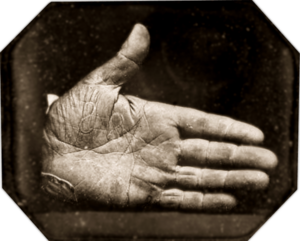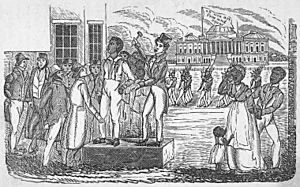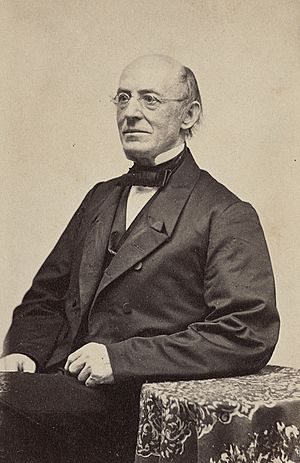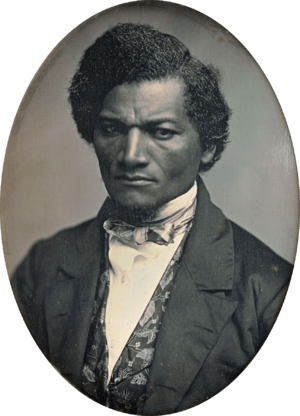John S. Jacobs facts for kids
Quick facts for kids
John S. Jacobs
|
|
|---|---|
| Born |
John Jacobs
1815 |
| Died | December 19, 1873 |
| Occupation | Author and abolitionist |
| Relatives | Harriet Jacobs (sister) |
John S. Jacobs (born around 1815 or 1817 – died December 19, 1873) was an African-American author and abolitionist. An abolitionist was someone who worked to end slavery. After escaping from slavery, he wrote his life story. It was called A True Tale of Slavery. This story was published in a London magazine called The Leisure Hour in 1861. John also appears in a famous book, Incidents in the Life of a Slave Girl. This book was written by his sister, Harriet Jacobs.
Contents
Life
Early Life in Slavery
John Jacobs was born in Edenton, North Carolina, in 1815. His mother, Delilah Horniblow, was enslaved by the Horniblow family. They owned a local tavern. John and his sister Harriet (born in 1813) had a father named Elijah Knox. Even though Elijah was enslaved, he was a skilled carpenter. He died in 1826.
John's mother died when he was four years old. He lived with his father until he was nine. Then, he was hired out to Dr. James Norcom. Dr. Norcom was the son-in-law of the tavern owner. John's sister Harriet also lived with Dr. Norcom.
In 1828, after the tavern owner's wife died, her enslaved people were sold. This happened at a public auction on New Year's Day. John, who was 12, his grandmother Molly, and Molly's son Mark were all sold. Being sold at an auction was a very hard experience for John. Dr. Norcom bought him, so John continued to live in the same house as his sister.
While enslaved by Dr. Norcom, John Jacobs learned some basic health care. He also taught himself to read. Very few enslaved people could read or write. Even after he escaped, John could not write his own story.
In June 1835, Dr. Norcom sold John Jacobs. He also sold Harriet and her two children. Dr. Norcom hoped they would be taken out of the state. This would separate them from their family forever. But the trader was secretly working with Samuel Tredwell Sawyer. Sawyer was a white lawyer and the children's father. He bought all three of them.
Escape and Fighting for Freedom
In 1838, John went with his new owner, Sawyer. He was Sawyer's personal helper on a trip through the North. John gained his freedom by simply leaving Sawyer in New York. Slavery had been ended there. Both John and his sister wrote in their books that John did his duties until the very end. He left everything in order and did not steal any money.
John tried to work during the day and go to school at night. But it was too hard. In August 1839, he went on a whaling trip. He took all the books he wanted to study with him.

After three and a half years, John S. Jacobs returned. He started calling himself John S. Jacobs after he became free. He became more involved with the abolitionists. These were people who wanted to end slavery. They were led by William Lloyd Garrison. In November 1847, John went on a speaking tour. It lasted four and a half months. He traveled with Captain Jonathan Walker. Walker was a white man. He showed his hand to prove how cruel slave owners could be. His hand had been burned with the letters SS. This meant "slave stealer." He got this mark after trying to help some enslaved people escape.
After that, Jacobs went on other speaking tours by himself. He spoke about ending slavery. In early 1849, he went on a 16-day tour with Frederick Douglass. Douglass had also escaped from slavery in 1838. This was only weeks before Jacobs escaped.
For a short time in 1849, John Jacobs managed an "Anti-Slavery Office and Reading Room." His sister Harriet helped him. This office was in Rochester, New York. It was in the same building as Douglass's newspaper, The North Star.
In 1850, a new law was passed called the Fugitive Slave Law. This law made it easier for slave owners to force escaped enslaved people back into slavery. John S. Jacobs spoke at rallies against this law.
At the end of 1850, he went to California. He wanted to try to find gold there during the California Gold Rush. Later, he went to Australia with Harriet's son, Joseph. He was again searching for gold. It is not clear if he left because of the Fugitive Slave Law. His sister said the law did not apply to John. This was because he was brought to the free states by his owner. He was not an escaped person who ran away on his own. However, William Lloyd Garrison later wrote that John left the country because there was "no longer any safety for him."
He did not find much gold in California or Australia. So, he went to England and became a sailor. His sister went to Great Britain in 1858 and again in 1867-1868. But they did not meet. John was at sea both times. He was in the Middle East in 1858 and India ten years later. Still, John S. and Harriet Jacobs always wrote letters to each other.
His Autobiography
The idea of writing about their experiences as enslaved people was not new to the Jacobs siblings. As early as 1845, Frederick Douglass had written his book, A Narrative of the Life of Frederick Douglass, an American Slave. John S. himself encouraged his sister to write her story. An abolitionist and feminist named Amy Post finally convinced Harriet. Harriet had met Amy through John. In 1853, Harriet started writing her book, Incidents in the Life of a Slave Girl. It was published in January 1861.
John Jacobs's own story is much shorter. It was published in four parts in February 1861. It appeared in the London magazine The Leisure Hour. The story was called A True Tale of Slavery. The first three parts tell about his life until he escaped and went on the whaling trip. The fourth part tells about cruel things he saw happening to other enslaved people.
Both John and Harriet wrote about their own experiences. They also wrote about experiences they had together. And they wrote about things that happened to the other sibling. Harriet's children first appear in John's story when they are put in jail with their uncle. This happened before they were sold to the trader. John's story does not clearly explain why Sawyer bought Harriet's children and her brother. It also does not explain why John was treated well by Sawyer. Sawyer did not treat his other enslaved people well. These things are only made clear in Harriet's book.
Harriet Jacobs changed all the names in her book. John Jacobs (called "William" in his sister's book) used the correct first names. But he only used the first letter of the family names. For example, Dr. Norcom is "Dr. Flint" in Harriet's book. But he is "Dr. N-" in John's story. The only exceptions in John's story are Sawyer and his own name. He first shortened Sawyer's name, but later wrote it fully. He signed a letter to Sawyer, written by a friend, saying he had left: "No longer yours, John S. Jacobs".
Family and Later Life
In the mid-1860s, when he was about 50, John S. Jacobs married Elleanor Ashland. She was an Englishwoman and had two children already. John and Elleanor had one child together, Joseph Ramsey Jacobs. He was born around 1866.
In 1873, John returned to the U.S. He came with his wife and the three children. They lived in Cambridge, Massachusetts. This was close to his sister Harriet and her daughter Louisa Matilda. John died that same year, on December 19, 1873. William Lloyd Garrison attended the funeral. Louisa Matilda had invited him. Harriet and Louisa Matilda Jacobs were later buried next to him at Mount Auburn Cemetery.
John's wife, Elleanor, stayed in the United States until she died in 1903. But it seems there was no more contact between Harriet Jacobs's family and Elleanor's family. Harriet's biographer, Jean Fagan Yellin, thinks Elleanor ended the connection. She might have done this so her children would not face American racism. It seems Joseph Ramsey Jacobs was able to live as a white person.
Images for kids
-
1845 daguerreotype of Walker's branded hand.










